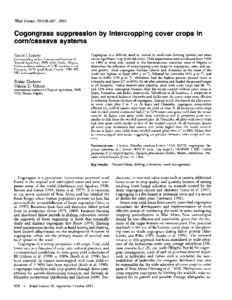| dc.description.abstract | Cogongrass is a difficult weed to control in small-scale farming systems and often causes significant crop yield reduction. Field experiments were conducted from 1996 to 1999 at three sites located in the forest/savanna transition zone of Nigeria to determine the influence of intercropping cover crops on cogongrass, corn, and cassava growth. Total cogongrass biomass (shoots and rhizomes) at the onset of the study was highest at Ijaiye (889 g m−2), followed by Umumba (445 g m−2), and least in Ezillo (138 g m−2). Velvetbean had the highest percent ground cover at Umumba and Ijaiye (67 to 89%) 10 wk after planting and shaded the ground longer at all locations. Twelve months after planting, plots with cover crops had 66, 71, and 52% lower cogongrass biomass than the weedy control without cover crops at Ijaiye, Umumba, and Ezillo, respectively. Velvetbean at all locations, L. purpureus at Ijaiye, and tropical kudzu at Umumba and Ezillo were the cover crops most effective in reducing rhizome biomass of cogongrass. Annual weeds dominated the plots sown to cover crops after 2 to 3 yr. At Ijaiye and Umumba, cogongrass competition affected the yield of cassava more than the yield of corn. At all locations, cover crops and weeded control treatments had 27 to 52% more corn grain yield than the weedy control. At Ijaiye, corn grain yields from velvetbean and L. purpureus plots were similar to that from the weeded control plot. At Umumba, all plots with cover crops had corn grain yields similar to that of the weeded control. At all locations, almost all cover crop treatments had cassava root yields higher than the weedy control. Except at Ijaiye, root yields from weeded control plots were 17 to 88% higher than in cover-cropped treatments, suggesting competition between cover crops and cassava. |

